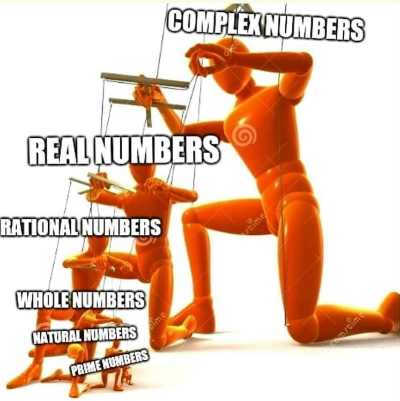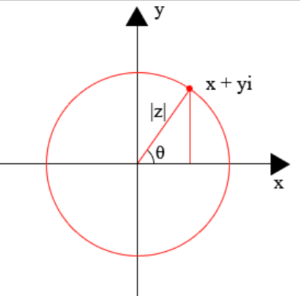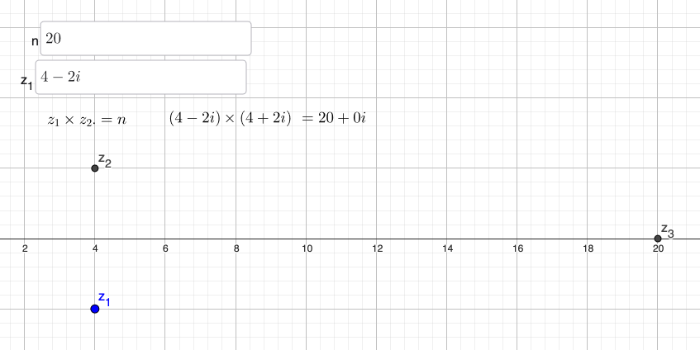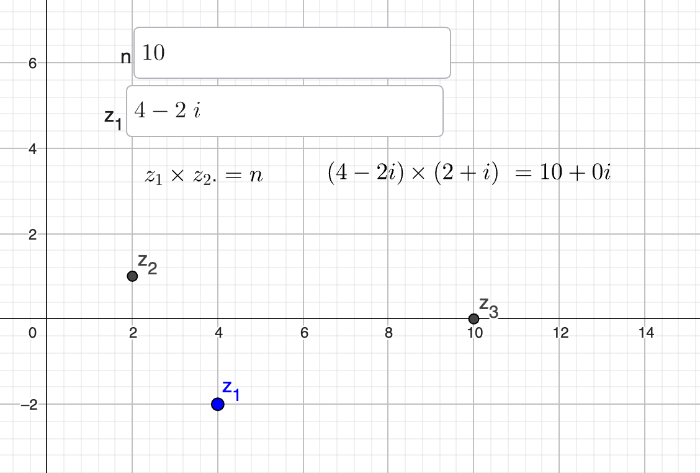Complex numbers AAHL 1.11,1.12
| Complex numbers | 複素数 | 복소수 | 复数 |
| Real part | 実部 | 실부 | 实部 |
| Imaginary part | 虚部 | 허부 | 虚部 |
| Modulus | 絶対値 | 모듈러스 | 模 |
| Argand diagram | アルガン図 | 아르간 도표 | 阿尔冈图 |
| Complex conjugates | 共役複素数 | 복소 공액 | 共轭复数 |
| Imaginary unit (i) | 虚数単位 | 허수 단위(i) | 虚数单位 |
| Geometric transformations | 幾何変換 | 기하학적 변환 | 几何变换 |

Inquiry questions
Factual Inquiry Questions
| Conceptual Inquiry Questions
| Debatable Inquiry Questions
|
Introduction
Complex numbers are written in the form , where:
- is the real part
- is the imaginary part
- i is the imaginary unit with the property that
For example,
has and
Checking your understanding
Given the complex number , where What are the real part and the imaginary part of the complex number ?
Consider the complex number defined by Determine the real part and the imaginary part of the complex number .
Geometric approach
Real numbers can be visualized on a number line. Each point on the line represents one real number.
In a similar way, complex numbers can be represented in a two-dimensional coordinate plane, where the horizontal axis represents the real part of the number, and the vertical axis represents the imaginary part of the number.
Each complex number , , is represented by a point in the plane and the coordinates are the real and imaginary parts of the complex number itself.
Purely real numbers lie on the x-axis, and purely imaginary numbers lie on the y-axis.
The Argand diagram

Part 1 - Experimenting with arithmetic with complex numbers
In this section we are exploring what the results of the operations of addition, subtraction, multiplication and division have on the numbers geometrically. We will look at much of this in more depth and for now it's just to see what we can see.
Experiment with adding different complex numbers
Consider these discussion questions
How does adding a real number to a complex number affect its position on the complex plane?
What is the result of adding two complex numbers geometrically in terms of movement along the axes?
Can you predict the sum of a real and an imaginary number by their positions on the complex plane?
What patterns emerge when adding complex numbers along the same line in the complex plane?
Adding complex numbers
Subtracting complex numbers
Consider these discussion questions
How does the result of subtracting from , as shown by , reflect their relative positions on the complex plane?
If and were points on a vector field, what would the vector represented by indicate?
How can we interpret the subtraction of two complex numbers in terms of movement along the real and imaginary axes?
What would be the geometric interpretation if were subtracted from , instead of from ?
If is fixed and varies, how does map out a path on the complex plane?
Experimenting with dividing complex numbers
Consider these discussion questions
How does the division of complex numbers alter their position on the complex plane?
What happens to the magnitude and direction of a complex number when it is divided by another complex number?
How can you use the concept of conjugates to simplify the division of complex numbers?
Can you predict the quotient of two complex numbers by examining their positions on the complex plane?
How does the division of a complex number by a real number compare to division by an imaginary number on the complex plane?
If and are both on a of the form , what do you notice?
Dividing complex numbers
Multiplying complex numbers
Consider these discussion questions
How does the multiplication of a complex number by a real number affect its position on the complex plane?
What type of number does multiplying two purely imaginary numbers together give?
What geometric transformation occurs when multiplying a complex number by i?
Can you predict the product of a complex number with a purely imaginary number based on their initial positions?
What is the result of multiplying two complex numbers that are each other's conjugates?
Multiplying complex numbers
Powers of a complex number
Consider these discussion questions
What happens to the magnitude of a complex number when it is raised to higher powers?
How does the angle of a complex number with the positive real axis change with successive powers?
Can you describe the pattern formed by the powers of a complex number on the complex plane?
What does the image suggest about the convergence or divergence of the powers of the complex number?
How would changing the initial complex number affect the pattern of its powers on the complex plane?
Can you predict the n-th power of a given complex number without actual calculation, using its position on the complex plane?
Take a complex number with a magnitude of 1. For example, or or what do you notice about powers of numbers of this form?
Part 2 - Arithmetic with complex numbers algebraically
Here we will explore how to add, subtract, multiply and divide complex numbers algebraically.
Part 2 - Arithmetic with complex numbers algebraically
Here we will explore how to add, subtract, multiply and divide complex numbers algebraically.
Experiment with your own examples to check that you can perform the four operations manually and with your GDC
Part 3 - Checking your understanding
Check your understanding with these exam style questions
Practice questions 1-6
Section A - style short response style questions 7-19
Challenge questions 20-21
[MAA 1.11-1.12] COMPLEX NUMBERS (CARTESIAN FORM)
[MAA 1.11-1.12] COMPLEX NUMBERS (CARTESIAN FORM)_solutions
Part 4 - Optional extension challenge
Part 4 - Optional extension challenge
Step 1: Multiplying a complex number by it's complex conjugate, will always give a real ouput. Can you algebraically prove this?

But what if we wanted a different real number, n.

Can you find the required for any given and ?
![[MAA 1.11-1.12] COMPLEX NUMBERS (CARTESIAN FORM).pdf](https://www.geogebra.org/resource/gjmxvhg5/CKgWwSQo0ayNPwBr/material-gjmxvhg5-thumb.png)
![[MAA 1.11-1.12] COMPLEX NUMBERS (CARTESIAN FORM)_solutions.pdf](https://www.geogebra.org/resource/hmutfjrj/kfqhBn18dnJtVPgM/material-hmutfjrj-thumb.png)

